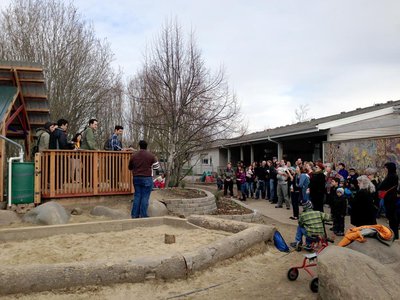
Everyone crowded around the new “playscape” at the Co-op Family Center on Patterson Street, not far from the UO campus, on a crisp February morning; hugs were exchanged, parents, teachers and college students chatted, kids were zooming around the new sustainable gravel bike path and bellies filled with pancakes and orange juice kept everyone warm. It was the Family Center’s 18th Annual Pancake Breakfast, but it was also the playground dedication — a playground designed and constructed by the UO student organization designBridge. The co-op’s pedagogical coordinator, Ben Minnis, called the cluster of designBridge students up to the stage that they had imagined and built with their own hands to thank them. The crowd hooted and hollered, and a ceremonial ribbon was cut.
One of the people on the stage that day was Jon Creighton, a UO architecture graduate student and project manager for designBridge’s Family Center project. “Basically they said, whatever you can do to make our playground better, whatever you can do to keep it from flooding, we’ll support,” Creighton recalls, a couple weeks later. Juli Brode, an architecture adjunct instructor and faculty adviser for the project sitting next to Creighton, nods.
“The mission of designBridge is two-fold,” Brode explains. “It gets at both student educational opportunity and it has an intention to provide services in the community — meaning design and construction services — for those who otherwise probably could not afford them.” Started by students in 2005, designBridge follows the ethos of design-build — where design and construction are done by the same entity — and has completed projects for local nonprofits like the HIV Alliance and Huerta de la Familia and schools, including bike shelters for Edison Elementary, Roosevelt Middle School and Camas Ridge Community School.
The Family Center playscape’s roots go back to the fall of 2011, when students like Creighton took the pre-design class that is linked to designBridge. During this phase, and the following construction phase that was completed in late 2012, Creighton says students gained real world skills through client communication (in this case, parents, staff, teachers and students ages 3 to 6), setting a budget with the client, researching materials, soliciting material donations from the community, developing a construction schedule and construction itself in addition to the actual designing.
Meeting with the students who would be engaging with the new environment was a large part of the process. The designBridge team went as far as to research the motor skills of this specific age group and designed with those perimeters in mind. “We did some activities like, ‘Take us outside and show us your favorite place on the playground and then we’ll talk about why it’s your favorite place,’ and we try to take some of those aspects and put them in our design,” Creighton says.
“In technical terms that’s called ‘affinity mapping,’ where you find the sacred places in a city or the sacred places in a site,” Brode says.
The final result has been fully embraced by the Family Center. Before the redesign of the playground, it often flooded due to an insoluble clay and sand mix in the soil. Now there is a wooden stage with a durable metal roof designed to help with rainwater drainage and a rain garden that drains the entire site through a system of rocks and a foot of round river gravel that allows water to percolate — the new playground has yet to flood. They also constructed a bike path out of decomposed granite, rather than the alternative of more expensive and less porous concrete. Creighton is quick to point out how involved the parents, teachers, staff and students were in the process.
“People from the co-op would come out and help. There were bigger build days with parents, staff and kids,” he says. Reflecting on his experience with the Family Center, and designBridge in general, Creighton says, “I got involved with it because it was a hands-on learning experience and I just wanted to be out there and build stuff. But then I eventually realized it was more than just design-build, it was learning about design through community interaction.”
For more information, visit www.designbridge.org